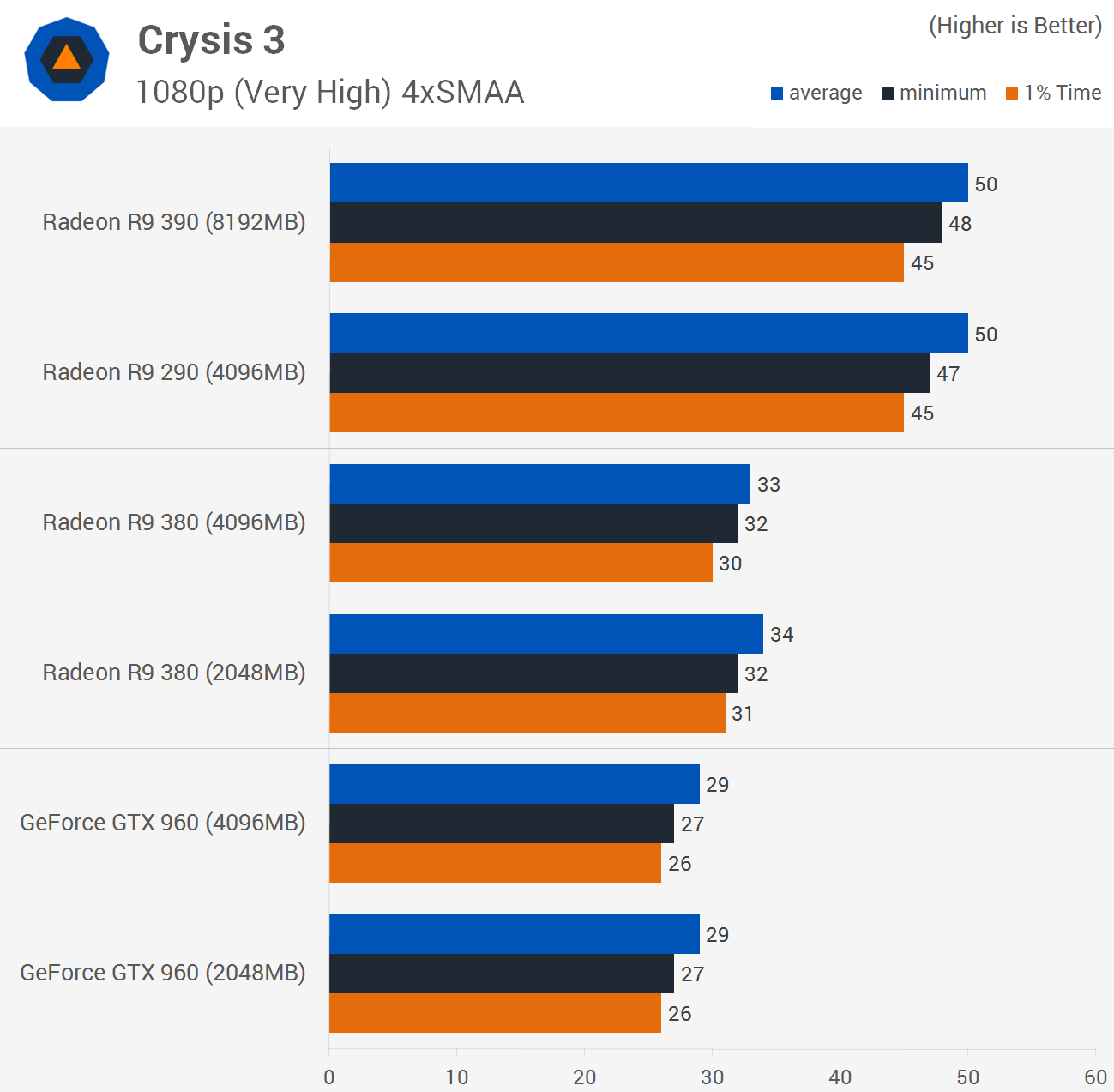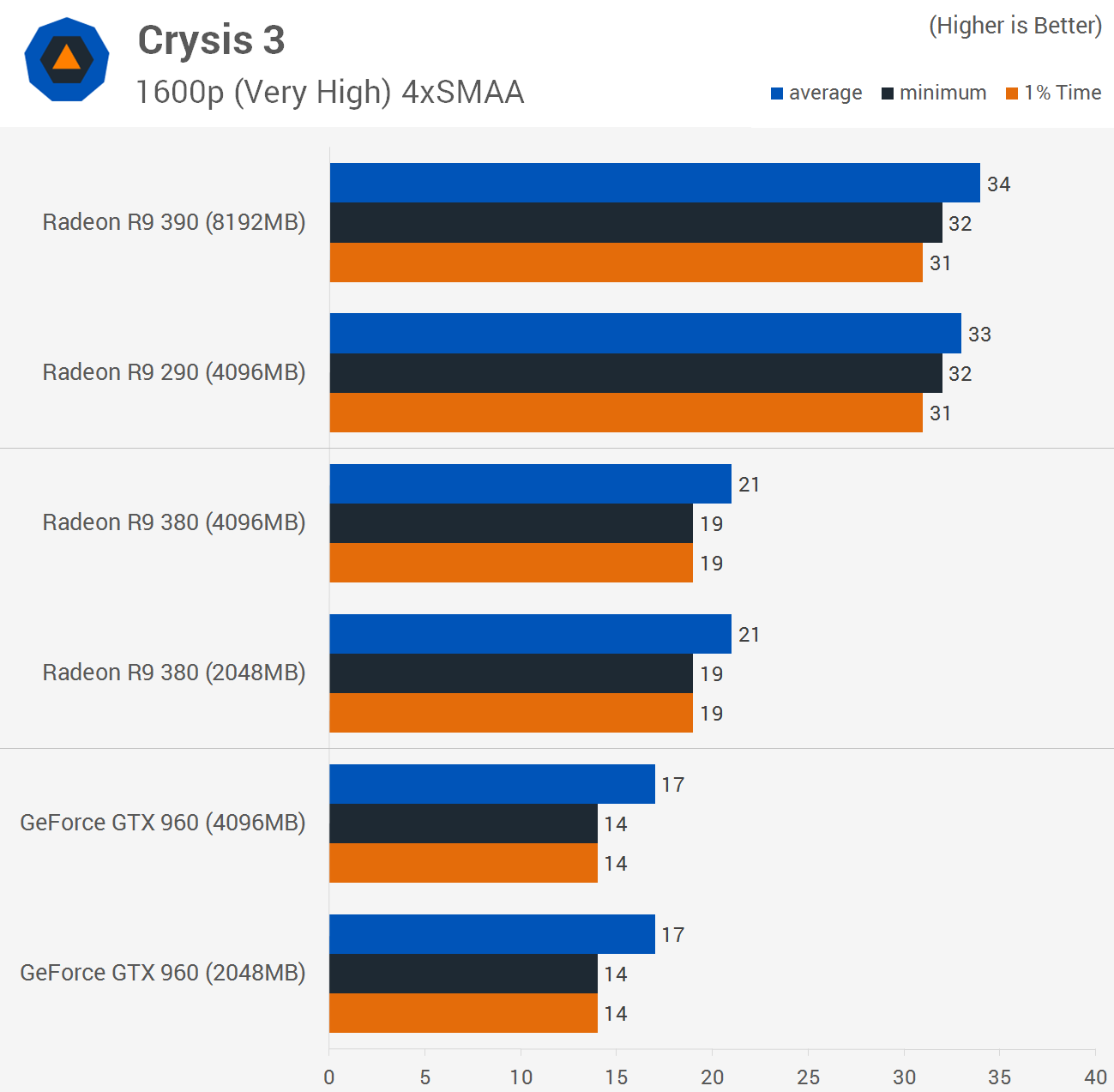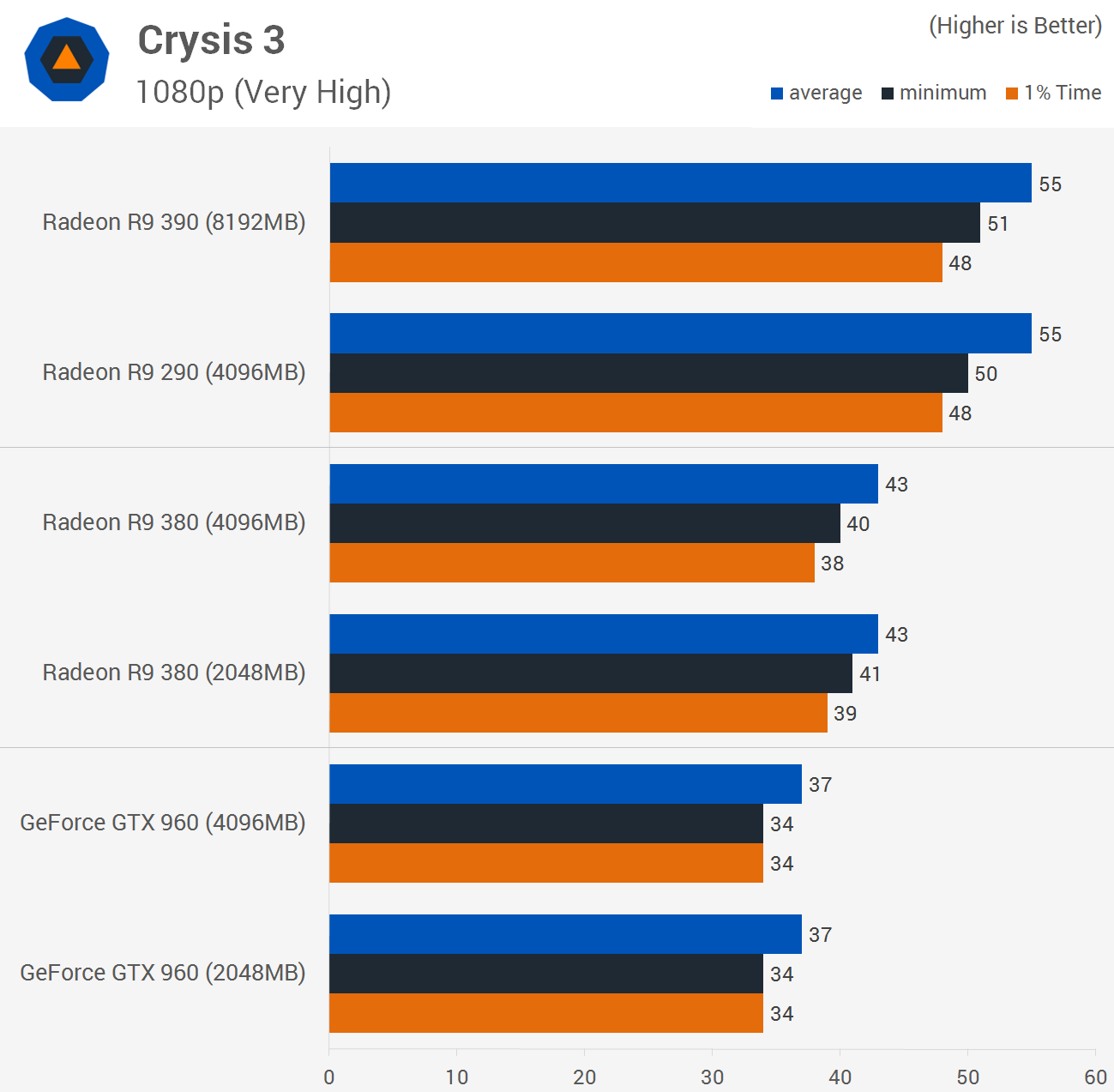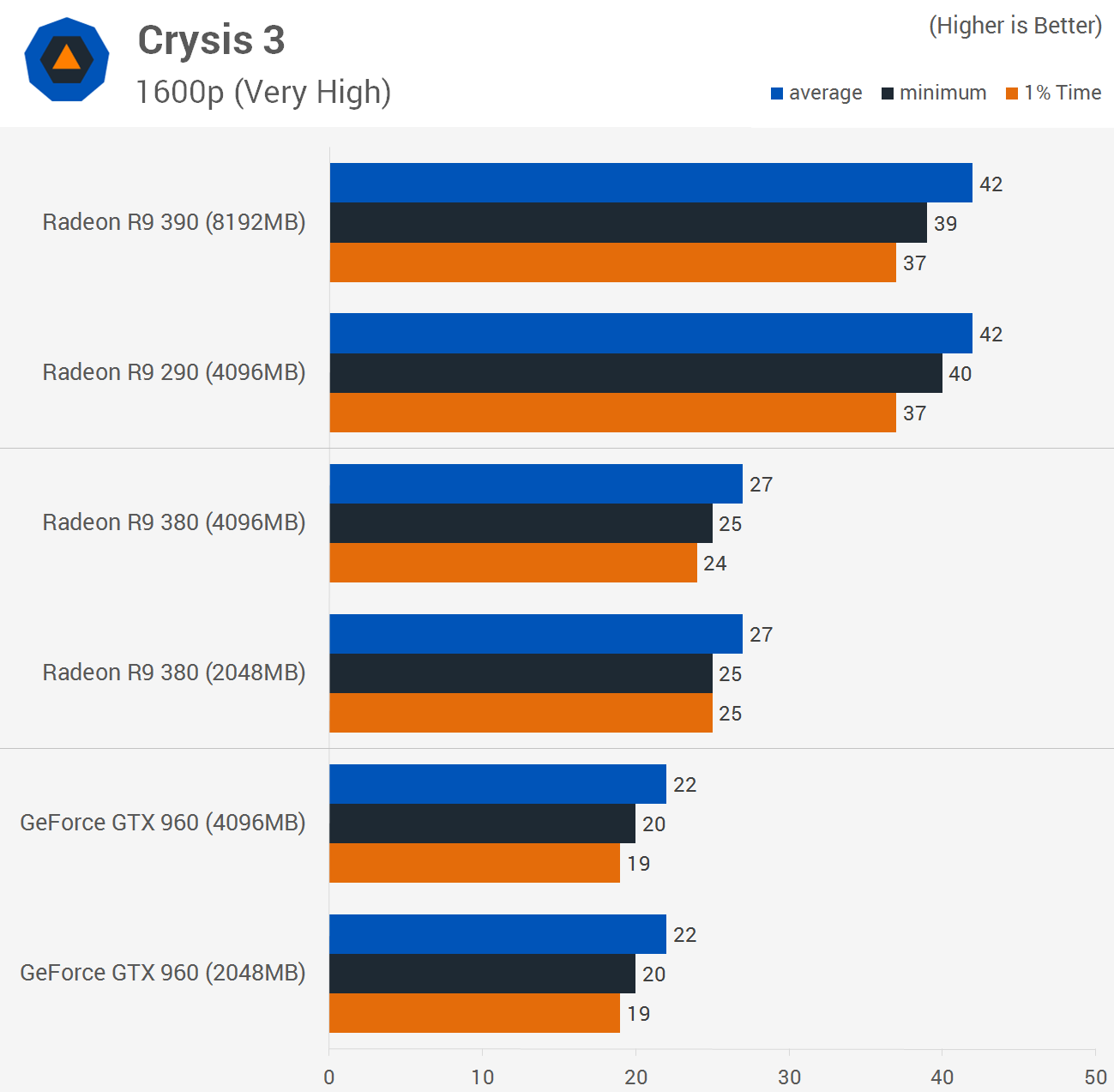VRAM Put to the Test: 2GB vs. 4GB GTX 960 and R9 380, 4GB R9 290 vs. 8GB R9 390
Just recently we completed our annual graphics card roundup where we looked at all current-gen GPU offerings from Nvidia and AMD and compared them at every price point. Standout products included the GeForce GTX 980 Ti and Radeon R9 390X, though at $400+ we realize these stellar graphics cards aren't for everyone.
There doesn't appear to be much concrete evidence online to assistance buyers make up one's mind between the two (2GB vs. 4GB). Yet we found almost forum threads were full of users recommending buyers avoid the cheaper 2GB cards in favor of the slightly more expensive 4GB models, described as "faster" and that they "won't limit performance."
It'due south usually the $200 options that will observe their mode into most gaming rigs. That means the GeForce GTX 960 or Radeon R9 380 will be the cards nigh will consider.
In our comparison we tested the 2GB models as nosotros felt they represented the best value, however since then we've received several reader inquiries regarding the performance departure between cards sporting 2GB and the 4GB models. Given past experiences, we would tend to say "not much," just with a mere $twenty price premium for the larger 4GB models, it got united states of america thinking.
There doesn't appear to exist much concrete evidence online to help buyers decide betwixt the 2. Yet we constitute almost forum threads were full of users recommending buyers avoid the cheaper 2GB cards in favor of the slightly more expensive 4GB models, described as "faster" and that they "won't limit performance."
Therefore nosotros have put together a clock-for-clock comparison of the GeForce GTX 960 and Radeon R9 380 using 2GB and 4GB cards. Also along for the ride is the previous-gen Radeon R9 290 4GB and the newer (rebadged) R9 390 8GB, which accept again been compared at the same clock speeds.
For testing we'll be using eleven games including new titles such as Tom Clancy'south Rainbow Six Siege, Star Wars Battlefront, Just Cause 3, Assassin's Creed Syndicate and The Witcher 3: Wild Chase. All games have been tested at 1920x1080 and 2560x1600 using ii graphics quality settings.
First we will await at a max VRAM usage scenario using the best in-game graphics quality settings, which we await to exist deadline playable on the mainstream GTX 960 and R9 380 with console-like 30fps. So we'll be backing off the quality settings a bit for a more realistic and desired gaming scenario.
Test Organization Specs
- Intel Core i7-6700K (4.00GHz)
- 2x 8GB Kingston Predator DDR4-3000
- Asrock Z170 Extreme7+ (Intel Z170)
- Silverstone Strider Series (700w)
- Crucial MX200 1TB (SATA 6Gb/s)
- HIS R9 390X IceQ Ten² 8GB
- HIS R9 290X iPower IceQ 10² 4GB
- HIS R9 380 IceQ X² 2GB
- HIS R9 380 IceQ Ten² 4GB
- Gainward GeForce GTX 960 Phantom 4GB
- Gainward GeForce GTX 960 Phantom 2GB
- Microsoft Windows ten Pro 64-fleck
- Nvidia GeForce 361.43 WHQL
- AMD Carmine Edition 15.12
Benchmarks: Crysis 3

Crysis three is withal a very visually impressive game though even with the graphics settings maxed out and 4xSMAA enabled, the game doesn't swallow upward a lot of VRAM. Despite that the Radeon R9 380 and GeForce GTX 960 both struggled to deliver smooth gameplay.
The 4GB 380 averaged 33fps while the 2GB model delivered a similar 34fps, clearly the cards' memory capacity isn't limiting performance in this championship. As you might expect the Radeon R9 390 and 290 delivered the aforementioned operation with an average of 50fps each.

Now at 2560x1600 we find 2.4 gigabytes of VRAM being used. In spite of exceeding the 2GB capacity of the GTX 960 and R9 380 2GB cards however both cards delivered identical performance as their 4GB variants.
Since nosotros are using less than 4GBs of VRAM in this examination it isn't surprising to find the 4GB 290 delivering the same functioning as the 8GB 390. The recurring theme here is that GPU horsepower is lacking well earlier memory capacity becomes the result.

Lowering the quality settings to more than realistic levels on the R9 380 and GTX 960 for smoother operation delivers similar performance trends, again the larger retentivity capacity cards have nix to offering in the way of performance.

Using the very high quality preset at 2560x1600 nonetheless sees the R9 380 and GTX 960 unable to deliver playable operation.
Benchmarks: Assassinator's Creed Syndicate

In stark contrast to the Crysis 3 examination, nosotros discover at that place is a large functioning difference between the 2GB and 4GB GTX 960 and R9 380 graphics cards in Assassin's Creed latest installment. Surprisingly at 1080p the 4GB 960 was 29% faster than the 2GB model, while the R9 380 4GB was also 17% faster than the 2GB model.
Although the 4GB models are clearly faster, both the GTX 960 and R9 380 averaged less than 30fps with minimums in the low 20s. So how relevant is this data? It will exist interesting to encounter if the 4GB models can even so bask a significant operation advantage under more playable weather condition.
The 8GB 390 and 4GB 290 provided similar average and minimum performance, though the 1% performance did heavily favour the 390 so that is something to keep an eye on.

At 2560x1600 the GTX 960 and R9 380 data tin be ignored as both 2GB and 4GB models were unable to get anywhere near playable framerates. The more expensive Radeon 390 and 290 also failed to deliver playable operation and were evenly matched. Information technology's worth pointing out that the game was seen using upwards to 4.8GBs of VRAM, and so once again when pushing this much data the 390 actually struggles.

Using the 'high' quality preset provides some interesting results. The GTX 960 is at present able to deliver a very playable 56fps boilerplate, though it is interesting to note that the aforementioned performance was achieved using both the 2GB and 4GB models.
All the same, this wasn't true for the Radeon R9 380 as the 4GB model was notwithstanding clearly the faster choice delivering a xv% greater boilerplate frame rate and a 23% higher minimum frame charge per unit. Although the 2GB model was still able to attain playable operation there is a clear statement for getting the 4GB model for Assassin's Creed Syndicate.

The GeForce GTX 960 and Radeon R9 380 struggled to provide playable performance at 2560x1600 and here the 4GB models aren't a great bargain faster than the 2GB models. Also the 290 and 390 both delivered the same 56fps average with similar minimum and 1% performance.
Benchmarks: One thousand Theft Auto V

Grand Theft Auto V at 1080p we can see that the 4GB R9 290 and 8GB R9 390 deliver the verbal same performance. Meanwhile the GTX 960 2GB and 4GB models delivered similar performance, though this wasn't the case for the R9 380. Here the 4GB R9 380 was considerably faster than the 2GB model, delivering 41% more performance at 1080p for what is not technically playable functioning.

Despite consuming 4.5GBs of VRAM there wasn't whatsoever difference between the 4GB R9 290 and 8GB R9 390.

Turning off 4xMSAA and the advanced graphics options nosotros see that the GTX 960 and R9 380 are able to deliver far better performance and under these playable weather the 4GB models take nothing to offering in the way of extra functioning.

Even at 2560x1600 with MSAA and Advanced Graphics disabled the R9 380 and GTX 960 are able to deliver playable performance in GTAV. Interestingly the 4GB models are over again unable to provide any additional performance.
Source: https://www.techspot.com/review/1114-vram-comparison-test/
Posted by: velezhavenou.blogspot.com


0 Response to "VRAM Put to the Test: 2GB vs. 4GB GTX 960 and R9 380, 4GB R9 290 vs. 8GB R9 390"
Post a Comment